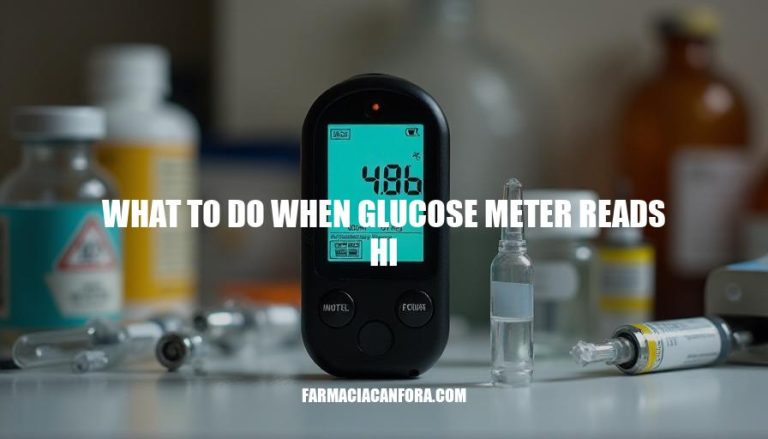


When a glucose meter reads “HI,” it indicates that blood sugar levels are dangerously high, beyond the meter’s measurable range. Understanding how to respond to this situation is crucial for individuals managing diabetes, as it helps prevent severe complications like diabetic ketoacidosis (DKA) and ensures timely medical intervention.
When a glucose meter reads “HI,” it means your blood glucose level is extremely high, exceeding the meter’s maximum measurable range. Typically, this range is around 600 mg/dL (33.3 mmol/L) or higher.
This is important to address promptly because such high levels indicate severe hyperglycemia, which can lead to serious complications like diabetic ketoacidosis (DKA) or hyperosmolar hyperglycemic state (HHS). Immediate action, such as rechecking your glucose level, administering insulin, and seeking medical attention, is crucial to prevent these life-threatening conditions.
Following these steps can help ensure accurate glucose level readings.
When a glucose meter reads “HI,” it indicates extremely high blood sugar levels. Here’s a concise guide on what to do:
Double-check the reading: Wash and dry your hands thoroughly, then recheck your blood sugar to ensure accuracy.
Administer insulin:
Hydrate: Drink plenty of water to help lower blood sugar levels and prevent dehydration.
Consult your healthcare provider: Always seek advice from your doctor or diabetes care team to confirm the appropriate insulin dose and ensure safe management of your condition.
It’s crucial to follow these steps carefully and consult with a healthcare provider to avoid complications.
When a glucose meter reads “HI,” it indicates extremely high blood sugar levels, often above 600 mg/dL (33.3 mmol/L). This can be dangerous and may lead to diabetic ketoacidosis (DKA), a serious condition where the body produces high levels of blood acids called ketones.
Importance of Checking for Ketones:
How to Check for Ketones:
Blood Ketone Meter:
Urine Ketone Test:
Interpreting Results:
Stay hydrated and follow your healthcare provider’s instructions closely. If you feel unwell or your ketone levels remain high, seek medical help immediately.
When your glucose meter reads “HI,” it’s crucial to stay hydrated. Dehydration can worsen high blood glucose levels because it reduces the water in your bloodstream, leading to a higher concentration of glucose.
To help manage this, drink plenty of water. You can also consume fluids like herbal teas or electrolyte solutions, but avoid sugary drinks as they can spike your blood sugar even more. Staying hydrated helps your kidneys flush out excess glucose, which is essential for stabilizing your levels.
If your glucose meter reads “HI,” it indicates extremely high blood sugar levels. Seek medical assistance immediately if you experience any of the following signs of severe hyperglycemia:
Call emergency services or go to the nearest emergency room if you have ongoing diarrhea or vomiting and can’t keep food or fluids down, or if your blood glucose levels stay above 240 mg/dL (13.3 mmol/L) and you have symptoms of ketones in your urine.
When a glucose meter reads ‘HI,’ it indicates extremely high blood sugar levels, often above 600 mg/dL (33.3 mmol/L). To respond promptly and accurately, follow these key steps:
Additionally, check for ketones using a blood ketone meter or urine test strip, and interpret the results accordingly. If you experience severe symptoms such as frequent urination, blurred vision, or loss of consciousness, seek immediate medical attention.
Staying hydrated is crucial to help manage high blood glucose levels and prevent complications like diabetic ketoacidosis (DKA).